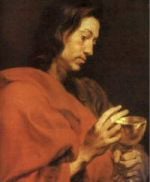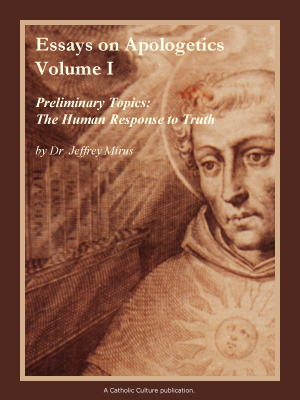The Enneagram: What's Your Number?
If you're a "seven," you're a compulsive optimist who likes everything warm and fuzzy.
"Sevens" don't get along very well with "fours," because "fours" are too "artsy" and think suffering is a way to be special in a plain world.
If you're not sure what number you are, perhaps you've never been exposed to the enneagram, a numerical system of nine personality types that is often popular with people involved in New Age philosophies. They use it for spiritual direction and self-knowledge.
Followers are taught how to identify their enneagram type, improve their personality, and "pray in sync" with whatever their "type" may be.
That might sound harmless, but it is not, according to the Pontifical Councils for Culture and Interreligious Dialogue.
In their 2003 document, "Jesus Christ the Bearer of the Water of Life: A Christian Reflection on the New Age," the councils describe enneagrams this way: "(T)he enneagram, [is a] nine-type tool for character analysis, which when used as a means of spiritual growth introduces an ambiguity in the doctrine and the life of the Christian faith."
The problem with the enneagram starts with its roots.
Derived from the Greek word "ennea," which means nine, and "gramma," which means line drawing, the enneagram is a circle around an inner triangle and hexagon.
At the nine points where the angles touch the circle are nine personality types: the perfectionist, the caregiver, the achiever, the artist, the observer, the team player, the optimist, the competitor and the peacemaker.
"The circle symbolizes creation and the unity of life," writes Father Mitch Pacwa, S.J., in his book, "Catholics and the New Age" (Servant, 1992) "The triangle represents the Trinity, the threeness in God, which is 'inside creation."'
But the Christian symbolism is just a veneer.
According to Father Pacwa's research, the enneagram entered Western culture through the teachings of two men: George Gurdjieff and Oscar Ichazo. Gurdjieff brought the actual symbol from the Orient, and Ichazo was responsible for applying the various personality "types" to the symbol.
Occult influences appear in the teachings of both men.
Gurdjieff was a Russian millionaire who established what he called the "Institute for the Harmonious Development of Man" in Moscow in 1922. He learned the enneagram symbol during his travels through central Asia. He claimed that Muslim mystics, known as Sufis, taught him the enneagram's numerology and other mystical uses, including divination — which is forbidden in Deuteronomy 18:9-14 and other Bible passages.
Ichazo's history is even more troubling. Born in 1931, Ichazo claimed he was having out-of-body experiences at the age of 6, which resulted in his leaving the church. He claimed that he could not accept Catholic teaching on heaven or hell because he had been there, and knew more about them than Christ and the church.
To gain control of his own consciousness, Ichazo studied Oriental martial arts, Zen, Andes Indian thought, shamanism, yoga, hypnotism and psychology. He joined esoteric groups in Bolivia and Argentina and traveled to Hong Kong, India and Tibet to study mysticism.
Ichazo claims to have received instructions from a higher entity, called "Metatron, the prince of the archangels." Members of his group contact lower spirits through meditation and mantras, and are guided by an internal master, known as the Green Qu' Tub, who makes himself known when a student reaches a sufficiently high stage of development.
Many instructors of the enneagram, including Ichazo and Gurdjieff, have claimed its roots go back as far as 2500 B.C. in Mesopotamia, but the only historic evidence Father Pacwa could find for the enneagram goes back no further than the 1960s.
His own enthusiasm for the enneagram faded as he became increasingly aware of serious problems with the concept, from its purported antiquity and links to occultism to a variety of theological problems. He also found there is a danger in using a scientifically untested system for the purpose of helping people deal with personality disorders.
That concern is shared by Christopher Rees, whose article "The Enneagram and Catholic Personalism" appeared in the April 2001 issue of the journal Homiletic and Pastoral Review.
"Unlike some 'personality type indices,' the enneagram remains untested by any scientific study," Rees wrote.
"Like Sufism, the 'dynamisms' adopted in each of the nine 'types' depends on which guru or shaikh you prefer," Rees added. "There are as many ways of constructing groups and interpreting the enneagram as there are gurus. So the only apparent similarity the enneagram shares with behavioral sciences is its lack of a paradigm."
Because the enneagram has descriptions that read like those for esoteric systems such as tarot cards, astrology and biorhythms, according to Rees, "advocacy of the enneagram by some Catholics is more problematic.
"The Gnostic roots manifest in all enneagram systems guarantee that enneagram systems can never be reconciled with the sacred deposit of faith," he said.
Those gnostic roots are also particularly troublesome to Father Lawrence J. Gesy, the cult consultant for the Archdiocese of Baltimore and the lead author of "Today's Destructive Cults and Movements."
"Gnosticism is a heresy that has existed since the time of the Greeks," Father Gesy said. "It is based on the belief that we are saved by our knowledge and not by our faith.
The truth, as taught by the Catholic Church, is different in that, he noted: "Our wisdom does not save us, but the humility to surrender to God's grace as the source of salvation is essential for the Christian self-transformation. We are not saved by our own merits or our wisdom — but with God's assistance. In other words, self-transformation is impossible, but transformation by God's grace is possible."
The enneagram joins other New Age beliefs because of its reliance on self rather than on God, Father Gesy said: "It gives credit to the creature rather than the Creator for the source of our being and salvation."
Father Pacwa agrees. "The mixture of so many non-Christian elements in the enneagram system raises the need to be very careful about accepting it wholeheartedly," he warned in his book.
In fact, Father Pacwa wrote, Catholics should be wary of putting their faith in any system that remains so untested, and which lacks any established norms for its concepts or instructors.
"No tests, no standards, no board of examination exists," he says, "so most enneagram 'experts' have that title through self-declaration and workshop advertising.
"People do not go to doctors and psychologists unless that practitioner is tested and licensed," Father Pacwa said. "Should not some similar requirement be made of enneagram teachers, who not only explain what your personality is like, but make recommendations about what you should be like?"
(This article originally appeared in The Catholic Standard and Times, the Philadalphia archdiocesan newspaper.)
Other articles in this series:
PART I: Popular Movement Is One of the Most Pressing Challenges to Christian Faith
PART II: Divination: Consulting Psychics and Mediums
PART III: Reiki and Healing Touch
PART IV: The Enneagram: What's Your Number?
PART V: Is Acupuncture Acceptable for Catholics?
PART VI: Bewitched by Wicca
PART VII: Ouija Boards and Tarot Cards
PART VIII: Energy Medicine: Part One — The Science
PART IX: Energy Medicine: Part Two — The Theology
PART X: The Exercise of Religion: Yoga
Ten questions to help you determine 'Christian or New Age?'
© The Catholic Diocese of Colorado Springs
This item 8757 digitally provided courtesy of CatholicCulture.org






